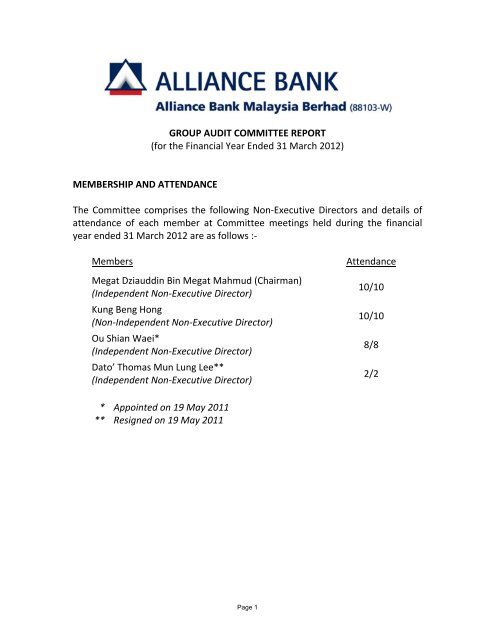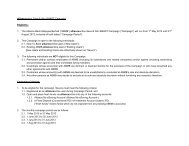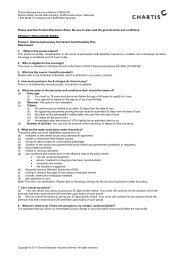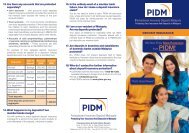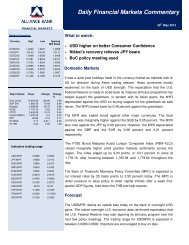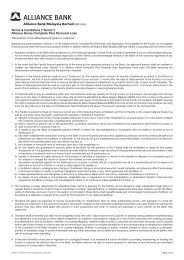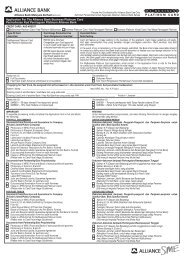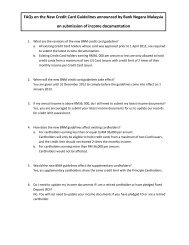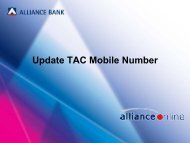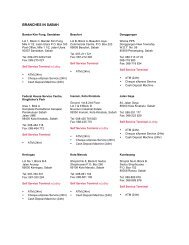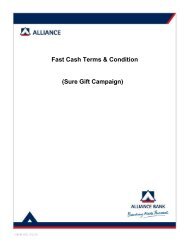Audit Committee Report - Alliance Bank Malaysia Berhad
Audit Committee Report - Alliance Bank Malaysia Berhad
Audit Committee Report - Alliance Bank Malaysia Berhad
You also want an ePaper? Increase the reach of your titles
YUMPU automatically turns print PDFs into web optimized ePapers that Google loves.
GROUP AUDIT COMMITTEE REPORT<br />
(for the Financial Year Ended 31 March 2012)<br />
MEMBERSHIP AND ATTENDANCE<br />
The <strong>Committee</strong> comprises the following Non‐Executive Directors and details of<br />
attendance of each member at <strong>Committee</strong> meetings held during the financial<br />
year ended 31 March 2012 are as follows :‐<br />
Members<br />
Megat Dziauddin Bin Megat Mahmud (Chairman)<br />
(Independent Non‐Executive Director)<br />
Kung Beng Hong<br />
(Non‐Independent Non‐Executive Director)<br />
Ou Shian Waei*<br />
(Independent Non‐Executive Director)<br />
Dato’ Thomas Mun Lung Lee**<br />
(Independent Non‐Executive Director)<br />
Attendance<br />
10/10<br />
10/10<br />
8/8<br />
2/2<br />
* Appointed on 19 May 2011<br />
** Resigned on 19 May 2011<br />
Page 1
TERMS OF REFERENCE<br />
1. POLICY<br />
It is the policy of <strong>Alliance</strong> <strong>Bank</strong> <strong>Malaysia</strong> <strong>Berhad</strong> (ABMB) and its subsidiaries<br />
to establish a Group <strong>Audit</strong> <strong>Committee</strong> to ensure that internal and external<br />
audit functions are properly conducted and that audit recommendations are<br />
being carried out effectively.<br />
2. OBJECTIVES<br />
2.1 To comply with regulatory guidelines on <strong>Audit</strong> <strong>Committee</strong> and Internal<br />
<strong>Audit</strong> Function.<br />
2.2 To provide independent oversight of ABMB and its subsidiaries’ financial<br />
reporting and internal control system and ensuring checks and balances<br />
within ABMB and its subsidiaries.<br />
3. COMPOSITION OF THE GROUP AUDIT COMMITTEE<br />
3.1 The Group <strong>Audit</strong> <strong>Committee</strong> shall be appointed by the Directors of ABMB<br />
and its subsidiaries, which shall fulfill the following requirements:‐<br />
a) the Group <strong>Audit</strong> <strong>Committee</strong> must be composed of no fewer than<br />
three members;<br />
b) all the Group <strong>Audit</strong> <strong>Committee</strong> members must be non‐executive<br />
directors, with a majority of them being independent directors;<br />
c) the members of the Group <strong>Audit</strong> <strong>Committee</strong> shall elect a Chairman<br />
from among themselves who shall be an Independent Director; and<br />
d) at least one member of the Group <strong>Audit</strong> <strong>Committee</strong>:‐<br />
i) must be a member of the <strong>Malaysia</strong>n Institute of Accountants; or<br />
ii) if he is not a member of the <strong>Malaysia</strong>n Institute of Accountants,<br />
he must have at least 3 years’ working experience and:‐<br />
aa) he must have passed the examinations specified in Part I<br />
of the 1 st Schedule of the Accountants Act 1967; or<br />
bb) he must be a member of one of the associations of<br />
accountants specified in Part II of the 1st Schedule of the<br />
Accountants Act 1967.<br />
Page 2
3.2 No alternate Director shall be appointed as a member of the Group <strong>Audit</strong><br />
<strong>Committee</strong>.<br />
4. SECRETARY TO THE GROUP AUDIT COMMITTEE<br />
The Company Secretary shall be the Secretary to the Group <strong>Audit</strong> <strong>Committee</strong>.<br />
5. QUORUM<br />
Two members of the Group <strong>Audit</strong> <strong>Committee</strong> shall constitute a quorum at any<br />
meeting and majority of members present must be Independent Directors to<br />
form a quorum.<br />
6. ATTENDANCE AT MEETINGS<br />
6.1 The Head of Group Internal <strong>Audit</strong> is invited to attend all meetings of the<br />
Group <strong>Audit</strong> <strong>Committee</strong>.<br />
6.2 The Head of Finance and the External <strong>Audit</strong>ors are normally invited to<br />
attend meetings as and when necessary.<br />
6.3 Other Board members and employees may attend meetings upon the<br />
invitation of the Group <strong>Audit</strong> <strong>Committee</strong>.<br />
6.4 The Secretary of the Group <strong>Audit</strong> <strong>Committee</strong> shall provide the necessary<br />
administrative and secretarial services for the effective functioning of<br />
the Group <strong>Audit</strong> <strong>Committee</strong>. The minutes of meetings are circulated to<br />
the Group <strong>Audit</strong> <strong>Committee</strong> Members and to all other members of the<br />
pertinent Boards.<br />
7. FREQUENCY OF MEETINGS<br />
The Group <strong>Audit</strong> <strong>Committee</strong> shall meet at least quarterly although additional<br />
meetings may be called at any time at the discretion of the Group <strong>Audit</strong><br />
<strong>Committee</strong>.<br />
Page 3
8. FUNCTIONS OF THE GROUP AUDIT COMMITTEE<br />
The functions of the Group <strong>Audit</strong> <strong>Committee</strong> are:‐<br />
8.1 To recommend the re‐appointment of the External <strong>Audit</strong>ors, the audit<br />
fee and any questions of resignation or dismissal and whether there is<br />
reason (supported by grounds) to believe that the External <strong>Audit</strong>ors are<br />
not suitable for re‐appointment;<br />
8.2 To discuss with the External <strong>Audit</strong>ors before the audit commences, the<br />
nature and scope of the audit, and ensure co‐ordination where more<br />
than one audit firm is involved;<br />
8.3 To recommend the nomination of a person or persons as the External<br />
<strong>Audit</strong>ors;<br />
8.4 To assess objectivity, performance and independence of the External<br />
<strong>Audit</strong>ors (e.g. by reviewing and assessing the various relationships<br />
between the External <strong>Audit</strong>ors and ABMB and its subsidiaries);<br />
8.5 To approve the use of the appointed external audit firm for non‐audit<br />
services including the non‐audit fees payable;<br />
8.6 To ensure that there are proper checks and balances in place so that the<br />
provision of non‐audit services does not interfere with the exercise of<br />
independent judgement of the External <strong>Audit</strong>ors;<br />
8.7 To review:‐<br />
a) with the External <strong>Audit</strong>ors, the audit plan;<br />
b) with the External <strong>Audit</strong>ors, their evaluation of the system of internal<br />
controls;<br />
c) with the External <strong>Audit</strong>ors, their audit report;<br />
d) the assistance given by ABMB and its subsidiaries’ officers to the<br />
External <strong>Audit</strong>ors; and<br />
e) the consolidated financial statements of ABMB and its subsidiaries;<br />
8.8 To review the quarterly, half‐yearly and year‐end financial statements of<br />
ABMB and its subsidiaries, prior to the approval of the Boards of<br />
Directors, focusing particularly on:‐<br />
a) any changes in accounting policies and practices;<br />
b) significant adjustments arising from the audit;<br />
c) any other significant and unusual events;<br />
Page 4
d) the going concern assumption; and<br />
e) compliance with accounting standards and other legal requirements;<br />
8.9 To ensure fair and transparent reporting and prompt publication of the<br />
financial accounts;<br />
8.10 To discuss problems and reservations arising from the interim and final<br />
audits, and any matter the External <strong>Audit</strong>ors may wish to discuss (in the<br />
absence of management where necessary);<br />
8.11 To review the External <strong>Audit</strong>ors’ management letter and management’s<br />
response;<br />
8.12 To regularly review the audit findings of the External <strong>Audit</strong>ors and<br />
Regulators and ensure that issues are being managed and rectified<br />
appropriately and in a timely manner;<br />
8.13 To review best practices on disclosure in financial results and annual<br />
reports of ABMB and its subsidiaries in line with the principles set out in<br />
the <strong>Malaysia</strong>n Code of Corporate Governance, other applicable laws,<br />
rules, directives and guidelines;<br />
8.14 To review the effectiveness of internal controls and risk management<br />
processes;<br />
8.15 To do the following in relation to the internal audit function:‐<br />
a) oversee the Internal <strong>Audit</strong> function and ensure compliance with<br />
requirements of regulators;<br />
b) review the adequacy of the scope, functions, competency and<br />
resources of the internal audit function, and that it has the<br />
necessary authority to carry out its work;<br />
c) review and approve the internal audit plan, review results of the<br />
internal audit process and where necessary ensure that appropriate<br />
actions are taken on the recommendations of the internal audit<br />
function;<br />
d) review internal controls including the scope of the internal audit<br />
program, the internal audit findings and recommend actions to be<br />
taken by the Management;<br />
e) regularly review the audit findings and ensuring that issues are being<br />
managed and rectified appropriately and in a timely manner;<br />
f) appoint, set compensation, evaluate performance and decide on the<br />
transfer and dismissal of the Head of Group Internal <strong>Audit</strong>;<br />
Page 5
g) ensure the compensation scheme of the internal auditors is<br />
consistent with the objectives and the demands of the internal audit<br />
function;<br />
h) consider the major findings of internal investigations and<br />
management’s responses;<br />
i) review the effectiveness of the infrastructure for ensuring Shariah<br />
compliance;<br />
j) establish an appropriate mechanism to address and manage<br />
situations where there is a threat to the objectivity of internal audit;<br />
and<br />
k) ensure the internal audit function is effective by establishing a<br />
mechanism to assess its performance and effectiveness.<br />
8.16 Where internal audit function lacks the expertise needed to perform the<br />
audit of specialised areas, external experts may be engaged. However,<br />
the Group <strong>Audit</strong> <strong>Committee</strong> remains responsible for ensuring that audit<br />
of specialised areas is adequate.<br />
8.17 In situations that external experts are engaged to carry out review of<br />
specialised areas where internal audit is not or not sufficiently proficient,<br />
the Group <strong>Audit</strong> <strong>Committee</strong> should ensure that:‐<br />
a) terms and scope of the engagement, the working arrangement with<br />
the internal auditors and reporting requirements are clearly<br />
established, and<br />
b) if the External <strong>Audit</strong>ors are engaged, the Group <strong>Audit</strong> <strong>Committee</strong> is<br />
responsible for ensuring that such engagement does not<br />
compromise the independence of the External <strong>Audit</strong>ors in their roles<br />
as statutory auditors of ABMB and its subsidiaries; and<br />
8.18 To consider and examine any other matters as defined by the Boards.<br />
9. AUTHORITY<br />
9.1 The Group <strong>Audit</strong> <strong>Committee</strong> is authorised by the Boards to:‐<br />
a) investigate any matter within the scope of the Group <strong>Audit</strong><br />
<strong>Committee</strong>’s duties;<br />
b) have full access to and co‐operation by management and full<br />
discretion to invite any director or executive officer to attend its<br />
meetings;<br />
Page 6
c) have full and unrestricted access to any information in ABMB and its<br />
subsidiaries;<br />
d) obtain independent professional advice or other advice, whenever<br />
deemed necessary;<br />
e) make recommendations for improvements of operating<br />
performance and management control arising from internal and<br />
external audit recommendations;<br />
f) have the resources which are required to perform its duties;<br />
g) have direct communication channels with the Internal and the<br />
External <strong>Audit</strong>ors; and<br />
h) able to convene meetings with the External <strong>Audit</strong>ors, the Internal<br />
<strong>Audit</strong>ors or both, excluding the attendance of other directors and<br />
employees of ABMB and its subsidiaries, at least twice a year.<br />
9.2 The Chairman and/or members of the Group <strong>Audit</strong> <strong>Committee</strong> are<br />
authorised by the Board to engage on a continuous basis with senior<br />
management, such as the Chairman, the Chief Executive Officer, the<br />
Head of Finance, the Head of Group Internal <strong>Audit</strong> and the External<br />
<strong>Audit</strong>ors in order to be kept informed of matters affecting ABMB and its<br />
subsidiaries.<br />
SUMMARY OF ACTIVITIES<br />
During the financial year, the <strong>Committee</strong> carried out the following activities:‐<br />
1. FINANCIAL RESULTS<br />
1.1 Reviewed the quarterly financial results with the Management before<br />
recommending them for approval by the Board of Directors.<br />
1.2 Reviewed the annual audited financial statements with the External<br />
<strong>Audit</strong>ors and the Management before recommending them for approval<br />
by the Board of Directors. The review was, inter‐alia, to ensure<br />
compliance with:‐<br />
a) The Companies Act, 1965,<br />
b) The <strong>Bank</strong>ing & Financial Institutions Act, 1989,<br />
c) Applicable approved accounting standards in <strong>Malaysia</strong>, and<br />
d) Other legal, statutory and regulatory requirements.<br />
Page 7
2. EXTERNAL AUDIT<br />
2.1 Reviewed with the External <strong>Audit</strong>ors, the management letter together<br />
with Management’s responses to the findings for the financial year<br />
ended 31 March 2011 and the half year ended 30 September 2011.<br />
2.2 Reviewed and endorsed the letter of engagement for the appointment<br />
of PricewaterhouseCoopers as statutory auditors for the financial year<br />
ended 31 March 2012.<br />
2.3 Reviewed the re‐appointment of PricewaterhouseCoopers as the<br />
External <strong>Audit</strong>ors for the financial year ended 31 March 2013 and setting<br />
of tolerance limit for carrying out non‐audit related services.<br />
2.4 Reviewed and approved the appointment of PricewaterhouseCoopers to<br />
perform the verification procedures in relation to the <strong>Bank</strong>’s submissions<br />
to Perbadanan Insurans Deposit <strong>Malaysia</strong> (“PIDM”) for the year of<br />
assessment 2012.<br />
3. INTERNAL AUDIT<br />
3.1 Reviewed with the internal auditors the internal audit plan and budget<br />
for the financial year ended 31 March 2012 to ensure adequate scope<br />
and coverage of the activities of the banking group.<br />
3.2 Reviewed internal audit reports, audit recommendations made and<br />
Management responses to these recommendations. The <strong>Committee</strong>,<br />
where appropriate has directed action to be taken by Management to<br />
rectify and improve the system of internal controls and procedures<br />
including anti‐money laundering measures, based on the internal<br />
auditors’ recommendations and suggestions for improvements.<br />
3.3 Monitored the implementation of the audit recommendations to ensure<br />
that all the key risks and controls have been addressed.<br />
3.4 Monitored the progress of the Group Internal <strong>Audit</strong> function in executing<br />
the audit plan, adequacy of resources to carry out the audits and<br />
assessed the performance of the Group Chief Internal <strong>Audit</strong>or.<br />
Page 8
3.5 Reviewed and approved the engagement of Messrs. KPMG Business<br />
Advisory Sdn Bhd to perform a co‐sourcing independent review with<br />
Group Internal <strong>Audit</strong> on the SME scorecard model validation on cosources<br />
basis.<br />
3.6 Reviewed and approved the engagement of The Institute of Internal<br />
<strong>Audit</strong>ors <strong>Malaysia</strong> (IIAM) to conduct an external quality assessment on<br />
the Group Internal <strong>Audit</strong> function. IIAM has reported that Group<br />
Internal <strong>Audit</strong> function is generally conformed to the International<br />
Standards for the Professional Practice of Internal <strong>Audit</strong>ing.<br />
GROUP INTERNAL AUDIT FUNCTIONS<br />
1. The Group Internal <strong>Audit</strong>’s primary role is to assist the <strong>Committee</strong> to<br />
discharge its duties and responsibilities by independently reviewing and<br />
reporting on the adequacy and effectiveness of the system of internal<br />
controls that mitigate critical risks.<br />
2. The authority of the Group Internal <strong>Audit</strong> is provided in the Internal <strong>Audit</strong><br />
Charter, which formally documents the roles, duties and responsibilities of the<br />
internal auditors. The Group Chief Internal <strong>Audit</strong>or reports directly to the<br />
Group <strong>Audit</strong> <strong>Committee</strong>.<br />
3. To assist the banking group in adopting the high standards of corporate<br />
governance, the internal audits carried out provide reasonable assurance that<br />
the system of internal controls continue to operate satisfactorily and<br />
effectively. These audits cover the review of the adequacy of risk<br />
management, operational controls, compliance with established procedures,<br />
guidelines and statutory requirements, quality of assets, computer application<br />
systems and management efficiency, amongst others.<br />
4. In line with the best practices, Group Internal <strong>Audit</strong> adopts a risk‐based<br />
approach that deploys audit resources to focus on significant risk areas and<br />
thus, enhance the effectiveness and efficiency of the audit function by<br />
prioritising the audits of areas which have been assessed as having potentially<br />
higher risks.<br />
5. The audit approach applies “Computer Assisted <strong>Audit</strong> Techniques” (CAAT)<br />
which enables audits to be carried out from base through the use of audit<br />
software, therefore enhance audit efficiency.<br />
Page 9
6. In the area of information systems, audits of various computer systems<br />
including the internet banking system are carried out to assess whether the<br />
systems are operating securely and with integrity.<br />
7. Prior to implementation of new business products, Group Internal <strong>Audit</strong><br />
assists Management in reviewing the control risks involved to evaluate<br />
whether such risks are properly mitigated.<br />
8. Group Internal <strong>Audit</strong> works collaboratively with Risk Management to monitor<br />
the risk governance framework and the risk management processes that are<br />
applied to ensure an acceptable level of risk exposure which is consistent with<br />
the risk management policy of the banking group.<br />
9. The internal auditors work closely with the external auditors to resolve any<br />
control issues raised by them to ensure that significant issues are duly acted<br />
upon by Management.<br />
10. The infrastructure and procedures to ensure that the <strong>Alliance</strong> Islamic <strong>Bank</strong><br />
<strong>Berhad</strong> is in compliance with Shariah principles are reviewed by Group<br />
Internal <strong>Audit</strong>.<br />
Page 10


